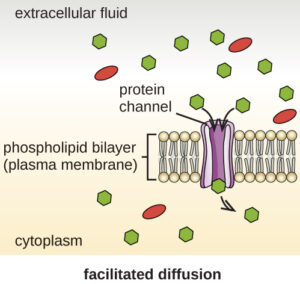Facilitated diffusion is the passive transport of molecules and ions across the plasma membrane which is aided by the channel proteins.
Channel proteins assist passage of the molecules, ions, polar bodies, charged molecules, nucleotides and amino acids through the cell membrane. This is a passive transport thus it doesn’t require energy while transporting the molecules and ions. In this section we shall discuss channel proteins facilitated diffusion.
What do channel proteins do in facilitated diffusion?
Channel proteins assist or ease the transport of water molecules, some small ions and polar ions through the plasma membrane. Here channel proteins facilitated diffusion is discussed.
Channel proteins ease the way for the transport of water molecules, ions, and minerals through the cell membrane by acting as pore. There are two types of channel proteins present in the cell membrane. They are water channel proteins called aquaporins and ions channel proteins.
The diffusion of ions, molecules, charged bodies need the channel proteins to travel via the cell membrane called plasma membrane. As the membrane doesn’t allow the passage of molecules and ions easily. For example glucose molecule is large in size so it can’t be passed though the membrane. The transportation of molecules across the membrane is assisted by channel proteins.
The same thing happens with the charged ions like calcium, potassium and sodium. We can see there is a difficulty in passage of amino acids, nucleic acids as these are polar and very large in size. So, these molecules diffusion is eased by the channel proteins through the membrane.

Wikimedia
What happens in facilitated diffusion channel proteins?
The channel proteins ease way for the transportation of large molecules, ions, polar bodies across the cell membrane.
The channel proteins aid the passage of the molecules, polar bodies, charged ions from the cell membrane (plasma membrane). The water channel proteins allow the passage of water molecules rapidly whereas ion channel proteins allow the passage of ions through the membrane.
How does facilitated diffusion channel proteins?
In facilitated diffusion the molecules flow freely through plasma membrane With help of proteins which are present in the membrane.
In facilitated diffusion the molecules enter the cell membrane with concentration gradient. This concentration gradient assists the molecules to pass the membrane by providing potential to them.
Is channel protein diffusion active or passive?
Channel protein diffusion is always a passive diffusion as in this process energy is not required.
We can say that channel protein diffusion is a passive diffusion process because whenever the molecules or ions travel through the membrane by the channel proteins.
Facilitated diffusion high to low channel proteins?
Facilitated diffusion is always a high concentration gradient to low concentration gradient.
In facilitated diffusion process the molecules travel from high concentration to low concentration gradient here they don’t require any energy while travelling.
Does facilitated diffusion require a protein channel?
In facilitated diffusion for the transport of molecules, ions, amino acids there is a need of protein channel.
The molecules like water molecules are bigger in size they require protein channel for travelling into or outside the cell. The charged ions also need protein channels.
Example of facilitated diffusion with a channel protein?
The glucose molecule transportation is the best example in facilitated diffusion by a channel protein.
The glucose molecule is bigger size and it needs to be transported through the plasma membrane. There are two types of glucose transporters.
Sodium glucose transporters:
These are usually present in renal tubules and small intestine and help the glucose molecules to travel opposite to the concentration gradient.
Facilitative glucose transporters:
These are transporters help in the bidirectional transport of glucose molecules.
Does facilitated diffusion uses proteins?
In facilitated diffusion the molecules and ions take the assistance of proteins.
In facilitation diffusion process the proteins assist the molecules, ions, salts to travel through the plasma membrane.
Does facilitated diffusion require a carrier protein?
In facilitated diffusion process the carrier proteins play a pivotal role in the transportation of molecules.
In facilitation diffusion process the carrier proteins are required as they allow the passage of charged and polar bodies like sodium, iodine, amino acids, sugars, nucleosides
Frequently asked questions:
What is the difference between diffusion and facilitated diffusion?
Diffusion is the process of transfer of molecules and ions from high concentration gradient to low concentration gradient.
Facilitated diffusion is the process of transfer of molecules and ions from high concentration gradient to low concentration gradient with the assistance of channel proteins.
What is osmosis?
Osmosis is the process of diffusion of water molecules through the cell membrane with help of channel or directly. This is also a passive diffusion process it doesn’t need energy.
What is meant by an active transport?
Active transport is the process of movement of molecules from low concentration gradient to high concentration gradient. This process require ATP molecules.
Active transport is diffusion of molecules from low concentration to high concentration gradient by energy like ATP molecules.
Define simple diffusion?
Simple diffusion is the process of molecules from high concentration gradient through the cell membrane without the assistance of membrane proteins. This is also a passive transport.
Also Read:
- Channel proteins
- Channel proteins passive transport
- Protein synthesis structure
- Protein synthesis process
- Monomer of protein example
- Channel protein active transport
- Channel protein transport
- Protein denaturation process
- Rna protein synthesis process

Hi…I am Nagasrilakshmi Narne, a postgraduate in Biotechnology and English. also completed my B.Ed. I worked in Vimtalabs as a project trainee and I have work experience as a faculty of English. So I can explain topics in simple language.
Let’s connect through LinkedIn